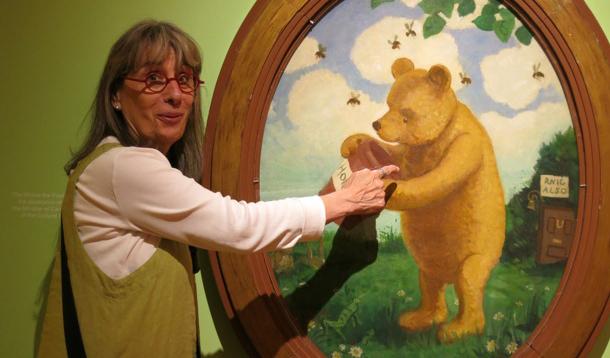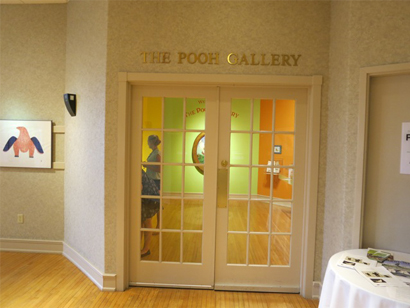
When you are a grandmother who loves to travel you often pick up information that you know your grandchildren would be really interested in. And if I use my grandkiddies as my 'sample audience of four' I believe most kids of seven+ who know about Winnie the Pooh would sit quietly as you showed them these photos and retold this story in your own words. This is especially true if you also tell them that Winnie turns 99 this year.

Recently I explored the lovely Assiniboine Park in Winnipeg, Canada. I was going there originally to see the English Gardens as well as the Leo Mol Sculpture Garden both of which enjoy excellent reputations. It was a lovely sunny day and I was really looking forward to my time there. What I didn't expect to also find in the park was free entrance to a permanent collection of Winnie the Pooh art and memorabillia. What a sweet find! And.. 'oh, the things I learned.'

Who knew that Winnie the bear was a real orphan bear cub that was bought in 1914 by Winnipeg veterinarian, Colonel Harry Coleburn? Colonel Coleburn named his bear 'Winnie" after the city of Winnipeg and subsequently sold the bear to the London Zoo.

Who knew that Christopher Robin was not just a figment of a writer's imagination? In truth this little boy was the son of A.A. Milne, the man who created Winnie the Pooh. Father and son often visited Winnie the Bear in the London Zoo and Dad's book and Winnie the Pooh stemmed from those visits. Other characters like Piglet were named after Christopher Robin's actual toys. And, according to the British Postal Museum website, 'Hundred Acre Wood' in which the stories are set was inspired by the Five Hundred Acre Wood near to where Milne lived in East Sussex.

A sign at the entrance to the collection told the full story of how both countries, Canada and England and four cities, White River, Quebec City, Winnipeg and London had a hand in making Winnie a beloved character for children around the world. The Pooh books are translated into almost every language; they are especially popular in Russia and Poland. And according to the British Postal Museum website,' there is a street in Warsaw named after Pooh.' Who would have guessed?

The illustrations in the book Winnie the Pooh were not done by A.A. Milne. What I learned was that the artist responsible for all the Pooh books was Londoner, E.H. Shepard. This E.H. Shepard painting of Winnie the Pooh is the only known oil painting of the famous teddy bear. It was purchased at an auction for $285,000 in London late in 2000 (Fact source Wikipedia). Today the painting is displayed at the Pavilion Gallery. What a treat it was for me to actually see that piece of art!

The Pooh Gallery exhibit includes the original illustration of Pooh and Piglet that was to be considered in page 103 of the book. This illustration was destined for Chapter 1, page 3.

How I wished I could have seen those actual pages in the first copies.

In 1979 London a special honor was bestowed on the Pooh creators. During the Year of the Child this 11-pence stamp was issued by the British Postal Service.

When I thought I had seen all that the tiny Pooh Gallery had to offer, I spied this sign which challenged me to look further. I had no idea where the Children's Nature Playground was located but this had now become a Treasure Hunt of sorts that I had to complete. A kind security guard sent me in the right direction.

And there it was. The Ontario black bear and the Winnipegger cast in bronze. Both Canadian heros. This sculpture by William Epp was dedicated to the "Children of the World' in August 1992.

Winnie the black bear died in the London Zoo May 12, 1934. The fictional Winnie the Pooh lives on in all our imaginations.
POSTSCRIPT: I received this note from Jane Childerhose a reader in California who writes ... Here are two photos. I still have the first 1920's edition of the Winnie the Pooh book that was my father's. The first shows that Shephard was, indeed, the series illustrator. The second photo shows how well worn the books were. If any other readers have photos related to this post or more background about Winnie the Pooh, please let me know. Who knows what we will find.

